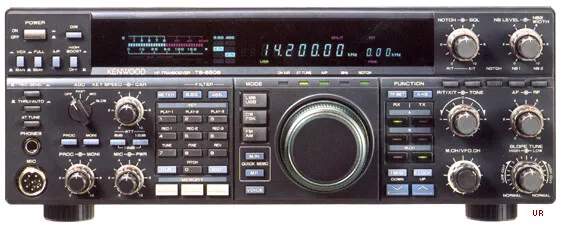
The Yaesu FT-891 is a compact, powerful, and versatile HF/50 MHz transceiver designed for amateur radio operators who demand high performance in a small footprint. Built with serious mobile and portable operators in mind, the FT-891 delivers a full 100 watts of power, all-mode functionality, a rugged design, and a user-friendly interface that caters to both newcomers and seasoned hams. This review takes an in-depth look at its features, performance, usability, and how it fits into a modern ham shack or mobile setup.
Design and Build Quality
The FT-891’s design is truly one of its strongest suits. Measuring just 6.1" x 2.0" x 8.6" and weighing about 4.2 pounds, the unit is compact enough to mount in most vehicles or tight operating spaces, yet it feels solid and well-constructed. Its all-black housing with a removable front panel makes mobile installations more convenient. The display is a crisp white-on-black OLED that provides excellent readability in various lighting conditions, including direct sunlight and nighttime environments.
The knobs and buttons are well-placed and have a durable feel, offering quick access to the most-used features like tuning, power, volume, mode selection, and noise blanking.
Power and Performance
With 100 watts of power output on HF and 6-meter bands, the FT-891 packs a strong punch for a radio of its size. The radio supports all traditional amateur modes: SSB, CW, AM, FM, and digital (with external interfaces). It is equipped with a triple-conversion superheterodyne receiver architecture and a 32-bit DSP unit for outstanding selectivity and filtering capabilities.
The receiver sensitivity is impressive, even in crowded band conditions. The 3 kHz roofing filter, combined with advanced DSP noise reduction, notch filtering, and variable bandwidth, ensures that weak signals can be extracted cleanly from noisy environments. The noise blanker and automatic gain control (AGC) options further enhance the operator's ability to deal with challenging RF conditions.
User Interface and Controls
Though compact, the FT-891 has a fairly intuitive menu system, with shortcut keys and programmable function buttons that reduce the learning curve. The front-facing USB port is particularly useful for firmware updates and digital mode operation when connected to a PC. While the screen may appear small compared to larger base station rigs, the essential operating information is clearly displayed.
The multi-function knob and quick function buttons give access to commonly adjusted parameters such as filter bandwidth, DSP settings, and power output. Some users may find the deep menu system a bit cumbersome at first, but Yaesu's logic remains consistent throughout, and with use, the layout becomes familiar.
DSP Capabilities
One of the key highlights of the FT-891 is its powerful 32-bit floating point DSP (Digital Signal Processor), which allows fine-grained signal manipulation. Adjustable filters include IF shift, notch filters (both manual and automatic), and noise reduction algorithms. These tools are especially valuable for working in noisy environments or during contesting and DXing.
The digital noise reduction (DNR) feature is particularly effective in removing background hiss and electrical noise without degrading the quality of the incoming signal. The DNF (Digital Notch Filter) automatically removes heterodyne carriers and whistling tones, making operation on crowded bands far more pleasant.
Mobile Use and Portability
The FT-891 is a natural fit for mobile operations, thanks to its detachable front panel, compact footprint, and included mounting bracket. The microphone and control cable are well suited for in-vehicle setups, and the front panel detachment allows for flexible placement options. Heat management is handled well via a large, quiet cooling fan that only engages when necessary, preventing overheating during extended transmissions.
Despite its small size, the FT-891 can serve well in base station roles when paired with a quality power supply and antenna tuner. While it lacks an internal tuner, many users combine it with external tuners such as the Yaesu FC-50 or third-party solutions to achieve a versatile home setup.
Connectivity and Digital Modes
The FT-891 includes a mini USB port for CAT control and firmware updates, which can also be used with popular digital mode software like FT8, PSK31, and RTTY when paired with appropriate interfaces. It lacks a built-in sound card, so an external sound card interface (like the SignaLink USB) is needed for full digital integration.
Although Bluetooth or Wi-Fi connectivity is not present, CAT control allows integration with logging software and rig control programs, making it a useful rig for field day or remote operations with a laptop.
Warranty and Support
The FT-891 includes a solid 3-year manufacturer’s warranty from Yaesu, which reflects confidence in the durability and reliability of the radio. Yaesu is known for strong customer support, and the widespread popularity of the FT-891 means there is a large user community, with plenty of resources and tutorials available to help operators get the most out of the rig.
Conclusion
The Yaesu FT-891 is a powerhouse in a small package. With 100 watts of HF/6m power, strong DSP filtering, and mobile-friendly features, it's a compelling option for anyone looking for a compact and capable transceiver. Whether you're a seasoned operator looking for a rugged mobile unit or a beginner stepping into HF for the first time, the FT-891 delivers solid performance, reliability, and value.
While it lacks some convenience features found in more expensive base rigs—like an internal tuner or built-in sound card—the FT-891's core performance and build quality more than make up for it. For portable, mobile, or space-conscious operators, it's an outstanding choice.








